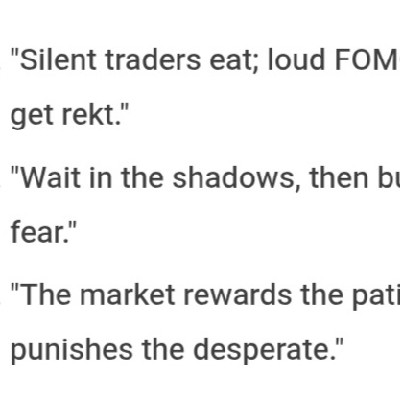
Memhash priceMemhash
Memhash market Info
Live Memhash price today in USD
The cryptocurrency market on December 2, 2025, finds itself navigating a landscape shaped by evolving regulatory clarity, significant technological advancements, and continued, albeit sometimes volatile, institutional adoption. Following a notable downturn at the start of December, with Bitcoin and major altcoins experiencing drops of over 5%, market participants are keenly observing key developments that could dictate the trajectory for the remainder of the year.
Market Performance and Price Drivers
The initial days of December have seen the crypto market start in the red, extending a downtrend from November where billions in value were erased across major assets. Bitcoin (BTC) dipped below $87,000, while Ethereum (ETH) saw its price drop significantly. Other major cryptocurrencies like XRP, BNB, and Solana (SOL) also experienced declines. This recent pullback is largely attributed to cautious trading sentiments ahead of the upcoming Federal Reserve interest rate decision, scheduled for December 15. Expectations are high for a rate cut, with data suggesting an 89% probability, which historically benefits risk assets like cryptocurrencies by increasing market liquidity.
Despite the short-term volatility, the broader outlook for Bitcoin and the crypto market in 2025 remains largely optimistic among many experts. Bitcoin had previously surged past $126,000 earlier in the year, reaching an all-time high. Analysts point to persistent institutional inflows and a more crypto-friendly political environment, particularly in the US, as strong bullish indicators. Some predict Bitcoin could still hit $250,000 by year-end, driven by improving dollar liquidity and potential future bank lending.
Evolving Regulatory Landscape
Regulatory developments continue to be a dominant theme, fostering a more mature and integrated crypto ecosystem. Stablecoin regulation is at the forefront, with significant progress across major economies. In the United States, the 'Guiding and Establishing National Innovation for U.S. Stablecoins (GENIUS) Act' was signed into law in July 2025, establishing the country's first comprehensive federal framework for payment stablecoins. This legislation defines payment stablecoins as digital assets redeemable 1:1 for dollars and backed by highly liquid, safe assets, explicitly clarifying they are not securities. Similarly, the European Union's MiCA (Markets in Crypto-Assets) regulation is seeing full enforcement by national regulators by the end of Q1 2025, requiring the delisting of non-compliant stablecoins by the end of January 2025. The UK is also prioritizing stablecoin regulations in 2025, consulting on issuance and custody rules.
Globally, this push for regulatory clarity is enhancing legitimacy and reducing systemic risks, making digital assets more appealing to institutional investors. The overall sentiment indicates a shift towards a more structured and innovative environment for the crypto industry, moving away from past uncertainties.
Ethereum's Fusaka Upgrade and Scaling Milestones
Ethereum is currently undergoing a pivotal period of technological advancement, with the 'Fusaka' upgrade set to deploy on its mainnet in December 2025. This landmark upgrade, following the 'Pectra' upgrade in May, is critical for enhancing Ethereum's scalability and performance. A key component of Fusaka is EIP-7594, known as PeerDAS, which significantly improves data availability for rollups by enabling nodes to sample smaller fragments of data, paving the way for an eightfold growth in blob capacity. The network's block gas limit was notably increased to 60 million on November 25, underscoring growing confidence in its robustness.
These advancements, combined with the continued rise of Layer 2 solutions, are dramatically scaling Ethereum's transaction capacity, with some solutions processing over 31,000 transactions per second. The goal is to eventually reach 100,000 transactions per second on-chain with optimized data storage and compression.
DeFi and Institutional Adoption Trends
Decentralized Finance (DeFi) continues to evolve at a rapid pace, with 'DeFi 2.0' introducing enhanced scalability, security, and user-friendly interfaces. Cross-chain interoperability, AI optimization, and increased regulatory clarity are driving this evolution. A major trend for 2025 is the tokenization of real-world assets (RWA), which is expanding the utility of DeFi beyond crypto-native assets by bringing tangible assets like real estate and bonds onto blockchain networks, with some reports valuing on-chain RWAs at over $12 billion.
Institutional adoption of cryptocurrencies has surged throughout 2025, with major financial institutions allocating increasing portions of their assets under management to digital assets. Bitcoin and Ethereum remain core holdings, but there's growing interest in high-growth assets like Solana and Polkadot, particularly those offering enhanced scalability and innovative DeFi applications. The integration of AI and blockchain technology is also creating new opportunities, with AI-powered DeFi platforms enhancing automation, security, and risk management.
In conclusion, despite recent market fluctuations, December 2, 2025, highlights a crypto market that is maturing rapidly, driven by robust regulatory frameworks, significant technological upgrades, and deepening institutional integration. These factors are collectively shaping a more resilient and widely adopted digital asset ecosystem.
Now that you know the price of Memhash today, here's what else you can explore:
How to buy crypto?How to sell crypto?What is Memhash (Memhash)What are the prices of similar cryptocurrencies today?Want to get cryptocurrencies instantly?
Buy cryptocurrencies directly with a credit card.Trade various cryptocurrencies on the spot platform for arbitrage.Memhash price prediction
What will the price of Memhash be in 2026?
In 2026, based on a +5% annual growth rate forecast, the price of Memhash(Memhash) is expected to reach $0.00; based on the predicted price for this year, the cumulative return on investment of investing and holding Memhash until the end of 2026 will reach +5%. For more details, check out the Memhash price predictions for 2025, 2026, 2030-2050.What will the price of Memhash be in 2030?
About Memhash (Memhash)
What Is Memhash?
Memhash is a decentralized mining project built on the TON blockchain. It provides an alternative approach to cryptocurrency mining by integrating a mining simulation game into Telegram. Unlike traditional Proof-of-Work (PoW) mining, which relies on powerful hardware and high energy consumption, Memhash allows users to participate with a simple in-app mechanism. This makes mining more accessible to a broader audience, including those using smartphones.
Initially launched as a Telegram-based game, Memhash has grown into a larger ecosystem that includes governance through a Decentralized Autonomous Organization (DAO), staking-like mechanisms, and plans for its own blockchain. The project has attracted a substantial user base, with over 1.8 million monthly users and a community that continues to expand.
How Memhash Works
Memhash operates through a simplified mining system designed to engage users with minimal technical requirements. The mining process involves pressing a single button, which triggers the app to search for a valid hash for the current block.
1. Mining Pool System
Unlike Bitcoin, where only the first miner to solve a block receives the reward, Memhash incorporates a mining pool system. This means that a portion of the block reward is distributed among all miners, ensuring that even users with lower computational power can earn rewards.
2. Energy-Based Mining Model
Mining in Memhash requires Energy, an in-app resource that depletes as mining progresses. Energy automatically regenerates over time, preventing users from over-mining. Players can also increase their Energy reserves through in-app tasks or purchases.
3. Mining Acceleration Options
Users can activate special mining modes such as Turbo, Super, or Nitro to increase mining speed by up to 20 times. Additionally, the platform offers an Offline Mining feature that allows mining to continue remotely without requiring users to keep their devices active.
4. Difficulty Adjustment Mechanism
To maintain a stable mining environment, Memhash automatically adjusts mining difficulty based on network activity. As more miners join the platform, the difficulty level increases to regulate block generation times and prevent excessive rewards.
5. Tokenized Economy
Mining rewards are issued in MEMHASH tokens, which can be traded on exchanges or used within the Memhash ecosystem for staking, governance, and future developments.
What Is MEMHASH Token?
MEMHASH is the native token of the Memhash ecosystem. Initially distributed through the mining process, the token has now been listed on major cryptocurrency exchanges, making it available for trading.
Tokenomics and Distribution
- Total Supply: 1.25 billion MEMHASH tokens.
- Mining Rewards: The initial block reward was set at 500 MEMHASH, with a gradual increase over time to prevent early adopters from gaining disproportionate benefits.
- Halving Mechanism: The platform reduces block rewards by 1% every 10,000 blocks until the reward stabilizes at 10% of the original amount.
Use Cases of MEMHASH
- Governance Participation: Holders can use their tokens to vote on project proposals within the Memhash DAO. The more tokens a user holds, the greater their voting power.
- Ecosystem Utility: MEMHASH tokens can be spent on in-app upgrades, increasing mining efficiency, or unlocking additional features.
- Trading and Liquidity: The token is listed on exchanges such as Bitget, allowing users to trade it against USDT and other cryptocurrencies.
- Future Integrations: Memhash has plans to expand MEMHASH utility by incorporating staking mechanisms, decentralized finance (DeFi) applications, and partnerships with other blockchain networks.
Should You Invest in Memhash?
Memhash introduces a new way to mine cryptocurrency without expensive hardware, making it more accessible to a wider audience. Its strong community, exchange listings, and future plans for governance and staking suggest potential for growth. For those interested in a low-barrier entry into crypto mining, Memhash could be worth exploring.
However, like any crypto project, there are risks. The long-term success of MEMHASH depends on sustained demand and adoption. As more users join, mining rewards could decrease, and market volatility may impact token value. If you’re considering investing, it’s important to do your research and assess whether Memhash fits your risk tolerance and investment goals.
Bitget Insights




Memhash resources
What can you do with cryptos like Memhash (Memhash)?
Deposit easily and withdraw quicklyBuy to grow, sell to profitTrade spot for arbitrageTrade futures for high risk and high returnEarn passive income with stable interest ratesTransfer assets with your Web3 walletWhat is Memhash and how does Memhash work?
Buy more
FAQ
What is the current price of Memhash?
What is the 24 hour trading volume of Memhash?
What is the all-time high of Memhash?
Can I buy Memhash on Bitget?
Can I get a steady income from investing in Memhash?
Where can I buy Memhash with the lowest fee?
Related cryptocurrency prices
Prices of newly listed coins on Bitget
Hot promotions
Where can I buy Memhash (Memhash)?
Video section — quick verification, quick trading









